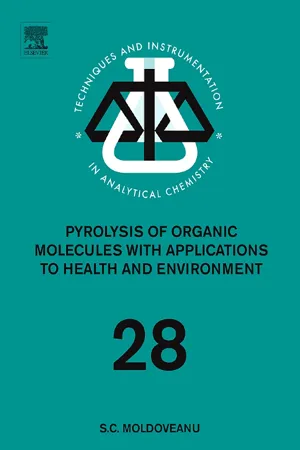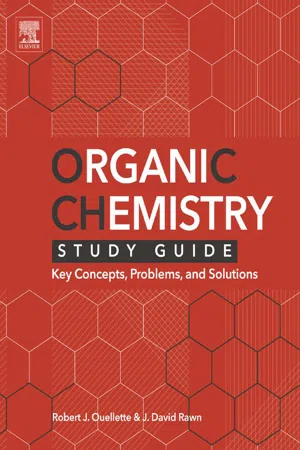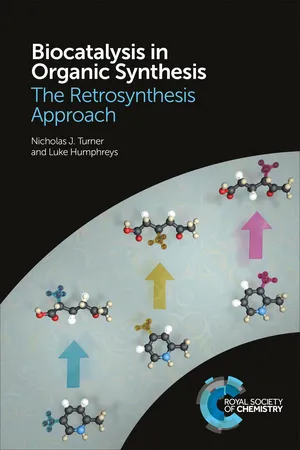Chemistry
Reactions of Esters
The reactions of esters involve processes such as hydrolysis, which breaks esters into alcohols and carboxylic acids, and transesterification, where the ester functional group is exchanged with another alcohol. Additionally, esters can undergo reduction to form alcohols or undergo nucleophilic acyl substitution reactions. These reactions are important in organic synthesis and the production of various compounds.
Written by Perlego with AI-assistance
Related key terms
Related key terms
1 of 4
Related key terms
1 of 3
3 Key excerpts on "Reactions of Esters"
- eBook - ePub
Pyrolysis of Organic Molecules
Applications to Health and Environmental Issues
- Serban C. Moldoveanu(Author)
- 2009(Publication Date)
- Elsevier Science(Publisher)
Chapter 19 Pyrolysis of Various Derivatives of Carboxylic Acids
S.C. Moldoveanu
19.1. Organic acid esters
General aspects
Organic esters are derivatives of organic acids R1 –COOH in which the –OH group from the acid is replaced by an alkoxy or phenoxy group –OR2 (sometimes phenoxy group is specified as –OAr). However, the formula for esters is frequently indicated as R1 COO–R2 (and not by the correct R1 CO–OR2 ) where the radical R1 is from the acid and R2 from the alcohol. The ester name is made from that of the radical R2 of the alcohol (or phenol) and the carboxylate name (name of R1 COO− ). As an example, the ester of butyric acid with ethanol, C3 H7 COO–C2 H5 , is ethyl butyrate. The naming can also be done with full specification of the acid name and alcohol radical plus the word “ester,” such as butyric acid ethyl ester for C3 H7 COO–C2 H5 .Typical reaction for the pyrolysis of esters that contain a hydrogen at the β-carbon in the R2 group from the alcohol moiety is the formation of an acid and an alkene as shown below:(19.1.1) The reaction takes place by an Ei concerted mechanism, as discussed in Section 2.2. The esters of alcohols that do not have a β-hydrogen in the alcohol moiety decompose differently under the influence of heat.Esters of alcohols that do not have a β-hydrogen
Pyrolysis of methyl esters cannot occur following reaction 19.1.1 since there is no β-hydrogen available. Methyl formate (formiate), for example, generates by pyrolysis a mixture of gases (53% CO, 43.1% H2 , 1.5% CH4 , 1.8% CO2 , and 0.6% HCHO) and liquids (H2 O and HCHO dissolved). The main reaction probably takes place as follows:(19.1.2) Typical for methyl esters, methyl acetate decomposes at higher temperatures than acetates of alcohols containing hydrogen atoms at the β-carbon (such as ethyl acetate). The decomposition of methyl acetate takes place with the formation of H2 , CH4 , CO, H2 - eBook - ePub
Organic Chemistry Study Guide
Key Concepts, Problems, and Solutions
- Robert J. Ouellette, J. David Rawn(Authors)
- 2014(Publication Date)
- Elsevier(Publisher)
15Alcohols: Reactions and Synthesis
Alcohols can react in several ways that differ in the number and type of bonds cleaved. These are:Keys to the Chapter
15.1 Overview Alcohol Reactions
1. Cleavage of the oxygen–hydrogen bond2. Cleavage of the carbon–oxygen bond3. Cleavage of the carbon–oxygen bond as well as the carbon-hydrogen bond at the carbon atom adjacent to the carbon atom bearing the hydroxyl group.4. Cleavage of the oxygen–hydrogen bond as well as the carbon-hydrogen bond at the carbon atom bearing the hydroxyl group.15.2 Converting Alcohols to Esters
Esters formed by the reaction of an alcohol with either an inorganic acid or a carboxylic acid have one feature in common. In both reactions, the oxygen atom bridging the alcohol and acid fragments is derived from the alcohol. The esterification reaction occurs by a substitution reaction mechanism in which a nucleophile attacks the carbonyl carbon atom to give a tetrahedral intermediate that subsequently ejects a leaving group. This process, known as nucleophilic acyl substitution, is another of the limited number of important mechanisms that dominate organic chemistry. We will meet this mechanism again in later chapters when we discuss the chemistry of acids and acid derivatives.Hydroxide ion is a poor leaving group, and ester synthesis proceeds much more easily with a better leaving group such as the chloride ion. Thus, the formation of esters by reaction of alcohols with acid chlorides is a more favorable process than reaction of alcohols with the acids themselves.15.3 Converting Alcohols to Haloalkanes
The conversion of an alcohol to a haloalkane can be done with thionyl chloride or phosphorus tribromide. In both cases, an intermediate is formed that converts the hydroxyl group into a better leaving group.The reaction mechanism of the reaction of an alcohol with thionyl chloride occurs through a chlorosulfite intermediate. Subsequent displacement by chloride ion can occur with retention or inversion of configuration depending on the solvent. In pyridine as solvent, inversion occurs. In dioxane, retention occurs via a solvated ion pair, in which the chloride attacks by an internal return mechanism. - eBook - ePub
Biocatalysis in Organic Synthesis
The Retrosynthesis Approach
- Nicholas J Turner, Luke Humphreys(Authors)
- 2018(Publication Date)
- Royal Society of Chemistry(Publisher)
Figure 3.2 , if we start with an ester, we can use a hydrolase and water to break the C–O ester bond to give a carboxylic acid and an alcohol.Figure 3.2 General transformation catalysed by hydrolases.This is exactly the same as if we had hydrolysed the ester chemically under either acidic or basic conditions. For acidic hydrolysis, we use a dilute acid such as hydrochloric acid to catalyse the reaction, whereas for basic hydrolysis we use hydroxide ions such as sodium hydroxide. These methods are easy to carry out, but we must be careful that the conditions of the hydrolysis reaction are compatible with the rest of the functional groups in the molecule, especially if we need to heat the reaction or use a strong acid or base. By comparison, enzyme-catalysed hydrolysis occurs under much milder conditions.There is also another advantage to carrying out a hydrolysis reaction using an enzyme: stereoselectivity. If we use a chiral ester as a substrate for the hydrolysis reaction, then the hydrolase enzyme will catalyse the reaction of one enantiomer of the ester faster than the other. This is because the enzyme itself is chiral and so will interact with enantiomers at different rates. As shown in Figure 3.3 , if we take a chiral ester that is a racemic mixture, then the hydrolase enzyme will hydrolyse one ester at a much faster rate, resulting in kinetic resolution.Figure 3.3 Kinetic resolution of an epoxide substrate catalysed by a hydrolase.In this particular example, we are interested in the chiral epoxide that is in the alcohol part of the ester that was hydrolysed. Instead of a racemic mixture of epoxides (which would be difficult to separate), at the end of the reaction we now have an ester and an alcohol, which we can separate easily.As we have already mentioned, both lipases and esterases will catalyse the hydrolysis of esters. However, when the ester is chiral, the two classes of enzymes prefer different substrates. As shown in Figure 3.4
Index pages curate the most relevant extracts from our library of academic textbooks. They’ve been created using an in-house natural language model (NLM), each adding context and meaning to key research topics.
Explore more topic indexes
Explore more topic indexes
1 of 6
Explore more topic indexes
1 of 4


